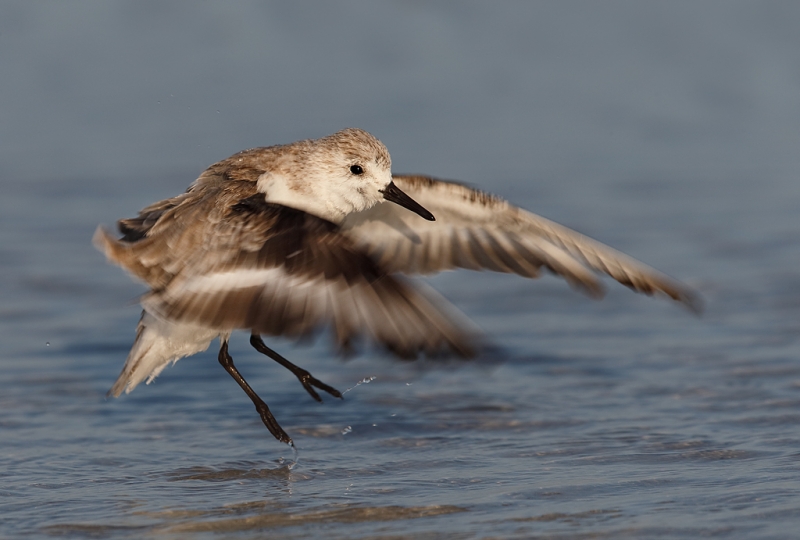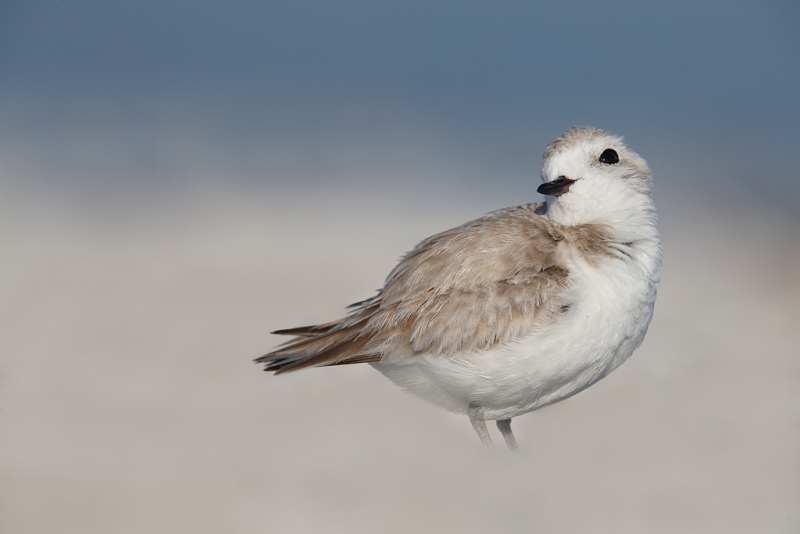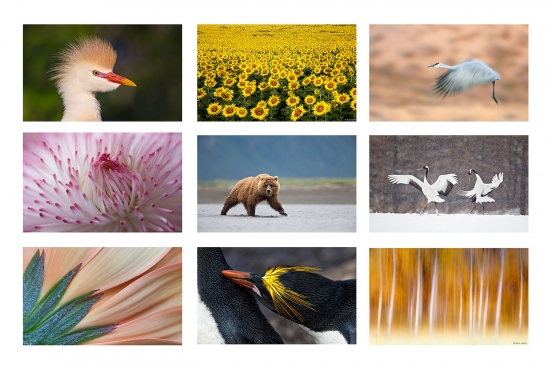|
This Sanderling image was created on Sanibel with the hand held Canon EF 600mm f/4L IS II USM lens, the Canon 2x EF Extender III (Teleconverter), and the Canon EOS-1D X Digital SLR camera. ISO 400. Evaluative metering -2/3 stop: 1/1000 sec. at f/10 in Manual Mode. Central sensor (by necessity) Expand/AI Servo/Rear Focus AF active at the moment of exposure. Click here if you missed the Rear Focus Tutorial. Click on the image to see a larger version. |
Baptism Under Fire
On Wednesday afternoon past, I took my new 600II for a walk on the beach at Sanibel in search of Snowy Plovers. I decided to go hand held. As you can see in the image below, I got down on the ground. I got my whole rig covered in sand. And I mean covered. It took me well more than an hour to clean everything up. But I had a great time. I had the 2XIII in place when I saw this Sanderling bathing. While standing at full height I got on sun angle and waited for the bird to flap. Fortunately I did not have to wait more than a few seconds as my left arm was getting tired quickly. I made four sharp images out of four. This one, a healthy crop from the rear and above and below, with the wings fully forward, was my favorite.
Do understand that for however long you are capable of hand holding a big lens you will do much better with flight and action than if you were on a tripod.
I let the gear dry overnight. To clean it, I used a 1 1/2 inch Linzer Best angular sash Blended Polyester paint brush from WalMart, the big Giotto’s Rocket Blower that I normally use for sensor cleaning, and a Q-tip with Lens Clens on it to clean the viewfinder. Poke-jabbing at the buttons with the paint brush worked wonders. When I was done getting rid of most of the sand, I cleaned the camera with an old T-shirt and Lens Clens. It needed that before the sand bath!
|
This image of a female Snowy Plover was also created yesterday afternoon on Sanibel. This one with the lens foot resting deep in the sand with the Canon EF 600mm f/4L IS II USM lens, the Canon 2x EF Extender III (Teleconverter), and the Canon EOS-1D X Digital SLR camera. ISO 400. Evaluative metering -1/3 stop: 1/1000 sec. at f/11 in Manual Mode. Central sensor (by necessity) Expand/AI Servo/Rear Focus AF on the bird’s eye and recompose. Click here if you missed the Rear Focus Tutorial. Click on the image to see a larger version. |
Just a moment after I created this image I called out to Denise Ippolito and Geri Georg, “This cute lady plover just gave me the coyest look.” I think that she was looking up at a bird in flight. The sharpness of the 600II/2X III/1D X is superb as expected. I cleaned the background extensively using Denise Ippolito’s cloning on a layer technique. This technique, along with my complete digital workflow, all of my Keyboard Shortcuts, and dozens more real world Photoshop tips is included in our Digital Basics File, a PDF that is sent via e-mail.
EOS-1D X AF Guide
You can learn exactly how I set up and use this camera’s great new AF system in our EOS-1D X AF Guide. And you can learn about our camera User’s Guides here.
Southwest Florida Site Guide
Several folks have written recently asking why this great guide has not been updated since 2007. The answer is that I have not discovered any new hotspots and that the good places remain good and the great places remain great. We found the Snowy Plovers on Wednesday in the exact spot described in the Southwest Florida Site Guide. Go figure.
Africa Photo Safari: August 2013
Serengeti Summer Migration Safari: 12 full and two half-days of photography: $12,999/person double occupancy. Limit: 12/Openings: 9.
Leaders: Todd Gustafson, Denise Ippolito, and Arthur Morris. Tanzania Summer Migration Safari. Leave the US on August 3. Day 1 of the safari is August 5. We will visit Tarangire for great dry season photography, Seronera Lodge–aka Leopard City!–twice, Central Serengeti for big cats, Northern Serengeti and our mobile tented camp to search for river crossings, and the spectacular wildlife spectacle that is Ngorongoro Crater. Our last morning of photography is August 18. Fly home from Arusha, Tanzania on the evening of August 18.
A deposit of $4,000 is due now. This trip is a go. Happy Campers only please. Guaranteed maximum no more than 12 photographers plus the three great leaders. 3 persons/van. You get a row of seats for yourself and your gear. In addition to rotating in-the-field instruction with each of the co-leaders, artie, Todd, and denise will be available for image sharing and review and informal Photoshop instruction during breaks and after meals. And–with apologies to Miss Manners–even during meals!
Once we cash your check you will be strongly advised to purchase travel insurance. You may wish to consider using Travel Insurance Services. Do understand that most policies must be purchased within two weeks of our cashing your deposit check. The 2nd payment of $4000 is due MAR 30, 2012. The final payment/balance is due MAY 30, 2013. Sign up with a friend or a spouse and apply a $300 per person discount.
The lodging is all first class. Please e-mail to request a PDF with additional details, the complete itinerary, and a description of the unparalleled photographic opportunities that we will enjoy. Please e-mail or call me on my cell at 1-863-221-2372 with any questions. I hope that you can join us.
You can see a collection of my images from previous safaris here.
Weekend Creative Nature Photography Seminar, Tampa, FL: February 23 & 24, 2013: $149
You are invited to join Denise Ippolito and me on the weekend of February 23-24 on the outskirts of Tampa, FL for a great weekend of fun and learning. Learn to improve your photography skills, your skill at designing images in the field, your creative vision, and your image optimization skills. Sunday critiquing session. Click here for additional details and the complete schedule.
Fort DeSoto Morning In-the-Field Workshop/Two Slots Left!
Fort DeSoto In-the-field Workshop: FEB 25. Pre-dawn -10:30am. Strict Limit 16/2 Openings. Includes a great working lunch: $275.
On Monday morning, February 25, Denise Ippolito and I will be co-leading a morning In-the-field Workshop at Fort DeSoto, south of St. Petersburg, FL. We should get to photograph a variety of very tame herons, egrets, gulls, terns, and shorebirds. Spoonbills possible. There will be lots of individual and small group instruction. We will cover exposure and histograms, seeing the situation, creating sharp images, and lots more. Each registrant will have a personalized gear and set-up check. The more questions you ask, the more you will learn.
A great working lunch at the Sea Porch Café on St. Petersburg Beach is included. All are invited to bring a laptop along for image sharing at lunch. After the workshop, all are invited to send us three 1024 wide or 800 tall JPEGs for critiquing. Call 1-863-692-0906 to register or send us a Paypal. Either way, be sure to note that the payment is for the Fort DeSoto In-the-Field Workshop.
Typos
On all blog posts, feel free to e-mail or leave a comment regarding any typos, wrong words, misspellings, omissions, or grammatical errors. Just be right. 🙂
Support the BAA Blog. Support the BAA Bulletins: Shop B&H here!
We want and need to keep providing you with the latest free information, photography and Photoshop lessons, and all manner of related information. Show your appreciation by making your purchases immediately after clicking on any of our B&H or Amazon Affiliate links in this blog post. Remember, B&H ain’t just photography!
Support the BAA Blog. Support the BAA Bulletins: Shop Amazon here!
And from the BAA On-line Store:
LensCoats. I have a LensCoat on each of my big lenses to protect them from nicks and thus increase their re-sales value. All my big lens LensCoat stuff is in Hardwood Snow pattern.
LegCoat Tripod Leg Covers. I have four tripods active and each has a Hardwood Snow LegCoat on it to help prevent further damage to my tender shoulders :) And you will love them in mega-cold weather....
Gizo GT3532 LS CF Tripod. This one replaces the GT3530LS Tripod and will last you a lifetime. Learn more about this great tripod here.
Mongoose M3.6 Tripod Head. Right now this is the best tripod head around for use with lenses that weigh less than 9 pounds. For heavier lenses, check out the Wimberley V2 head.
Double Bubble Level. You will find one in my camera's hot shoe whenever I am not using flash.
The Lens Align Mark II. I use the Lens Align Mark II pretty much religiously to micro-adjust all of my gear an average of once a month and always before a major trip. Enjoy our free comprehensive tutorial here.
BreezeBrowser. I do not see how any digital photographer can exist without this program.
Delkin Flash Cards. I use and depend on Delkin compact Flash Cards and card readers most every day. Learn more about their great 700X and 1000X cards here or about my favorite Delkin card here.

















That snowy plover is one of the sweetest images ever.
Agree!
Agree with what???
I deleted two sentences after the word I intended to post, ‘agreed’. Sentences that were going on to compliment your work but felt it unnecessary here, after this person’s post. I didn’t see that the letter ‘d’ was taken out too before I hit submit. The exclamation point was at the end of said sentences which I left in.
I was trying agree with the plover image being sweet.
Hi Matthew. I took out the “d”as out of context it made more sense. I never had a reply sent to be moderated before so I was the one who was confused :).
BTW, compliments of me and my work are always graciously appreciated :).
later and love, artie
Artie: Wonderful images as usual. How did you get the sand the plover was standing in to appear so out-of-focus?
The sand hill was several inches in front of the bird.
Amazing; it looks as if the bird is floating in fog, because none of the sand is in focus. Thanks.
The coy female is absolutely lovely. Don’t you carry Skimmers in your store? ;-0
Yes, and at the time, mine was in the back of my SUV. Just a bit of muddled thinking on my part. I was fine with the hand holding and getting sharp images but the Skimmer would have avoided the sand bath for my gear….
Artie – that coy snowy is a definite wall-hanger! Wow!
Art, with all the video capabilities of these modern cameras it would be cool to see a video of you in action photographing these birds, seeing you covering all that expensive gear in sand!
After we do the Tampa Seminar video we plan on doing a few of those….
Great Sanderling photo! The only improvement I could see is to have the wings fully stopped. Is that even possible given the parameters? The wings appear to have motion blur due to the 1/1000 shutter speed. If you shot at a faster shutter speed the DOF would probably produce similar results. What are your thoughts on this?
Thanks Jack. I’d guess that a shutter speed of 1/4000 sec or faster might have stopped them. Might. I rather like the blur. Remember, when photographing hummingbirds at multi-flash set-ups, you are working at effective shutter speeds of around 1/18,000 sec. Those interested are directed to our “How to Photograph Hummingbirds Using High-Speed Multiple Flash” eGuide.
These images, it goes without saying, are excellent. Hate to do it but I guess there is really no reason to hang on to the 800 any more. I greatly appreciate your posting this information as it makes people like me more confident in making the change. Thanks for being so willing to share your expertise over the last 20+ years.
You are most welcome. The only reason to hold onto the 800 now is cost. I guess that I used the eight with the 2X less than 1/10 of 1% of the time. YAW. If you do purchase one, the best way to thank us it to use our B&H affiliate link: Canon EF 600mm f/4L IS II USM lens
It would be greatly appreciated.
That Snowy Plover is fantastic…the name matches perfectly
with fore and background.
Doug
Thanks Doug. Hand holding at 1200mm is not exactly chopped liver. Wait till you see the next Sanderling image coming soon!
You say your rig was covered in sand. That would scare me, knowing how expensive it is. Is there no fear of getting sand in the camera and or in the lens to some extent? What are you cleaning methods in a situation like that.
Love the photo, BTW, so I know it’s worth it to get down low!!! 🙂
I am fearless. And as a Canon Explorer of Light, I get free repairs. I have been getting sand on my gear for decades. And mud too. The idea is to get the image and getting low on the beach is the way to go. Next time I will use my Skimmer II Pod though…
As you typed, I was updating this post with the gear cleaning stuff.
Great pose on the Snowy Plover!
Artie,
Perhaps in a future blog you can expand on this statement you made: “Do understand that for however long you are capable of hand holding a big lens you will do much better with flight and action than if you were on a tripod.” So I would be better off doing all my birds in flight photos hand-held?
Marv
Hey Marvin, Not much to expand on. Denise is doing an article on this very subject, however, in the next edition of her great MiniMag.
You can do great flight and action stuff off a tripod. The more you practice the better you will do. As for your question, yes, as long as you can comfortably hold the weight of your rig.
LOVE the Snowy image. Just a great capture of this delicate little lady.
I love the pose of the coy female, the background and ethereal foreground are awesome.